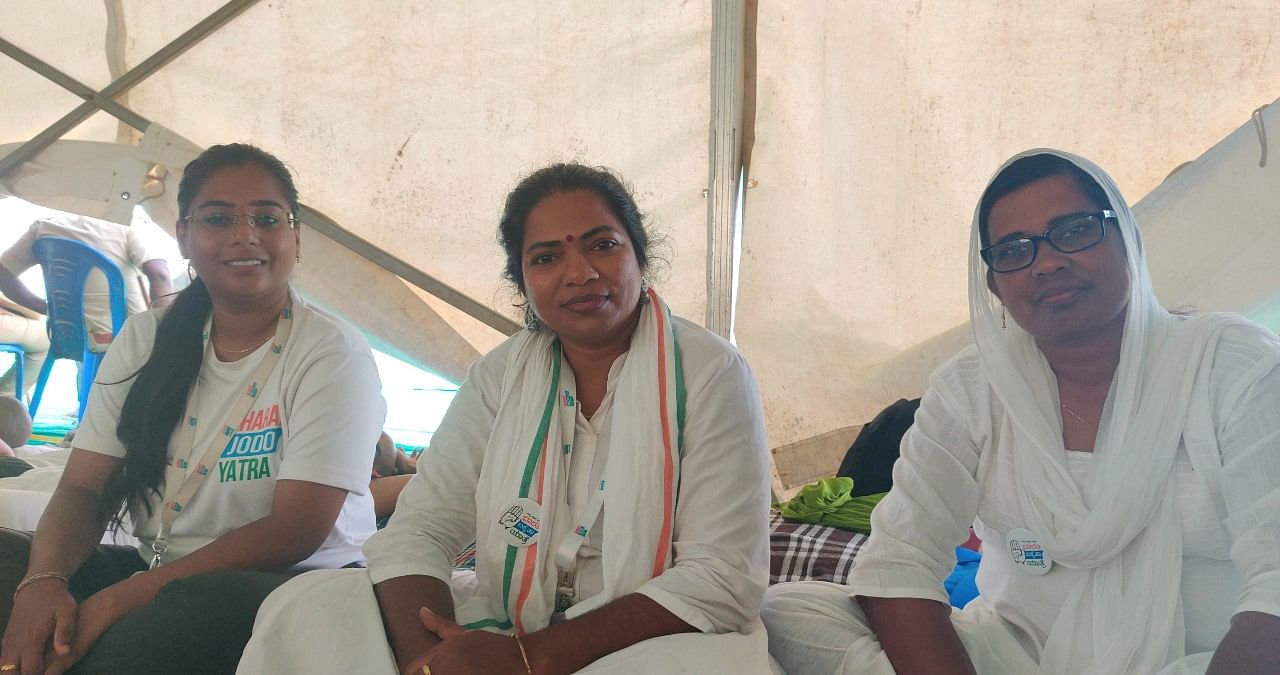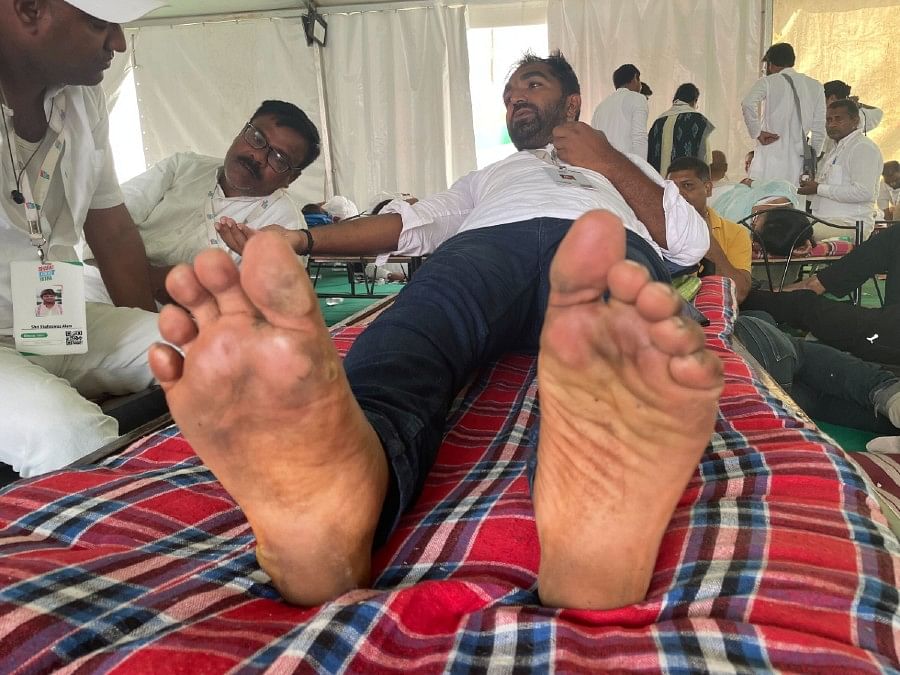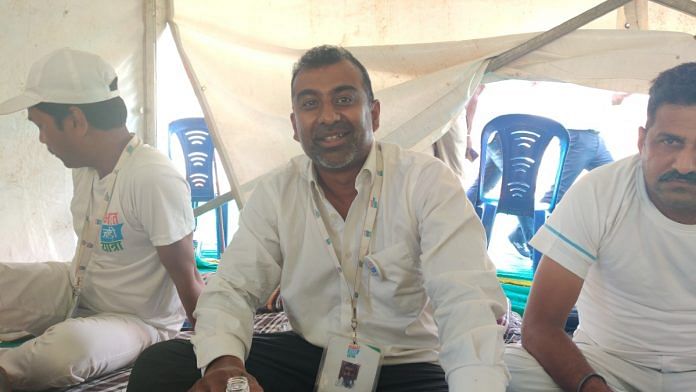Tumkur, Karnataka: It’s been a month since Rahul Gandhi and 150 ‘Bharat Yatris’ set off on the 3,570 km Bharat Jodo Yatra from Kanyakumari to Kashmir. By the time the yatra reached Karnataka after crossing two states, many of the yatris had, however, started feeling the heat.
As ThePrint spends time with the yatris in Tumkur, many show off blisters like battle scars, while others spoke about walking with 102-degree fever. A few others speak of home and leaving behind family and children to participate in what they describe as an “experience of a lifetime”.
The process of choosing the Bharat Yatris was about three weeks long, says Congress general secretary Jairam Ramesh. “There was a two-member committee that consisted of Mukul Wasnik and Digvijaya Singh. They vetted thousands of applications that came in from the PCCs (Pradesh Congress Committees),” says Ramesh.
Age, fitness, length of service in the Congress, and recommendations from the PCCs were some of the factors taken into consideration while drawing up the final list, he says.
Of the 150 yatris, about 30 per cent are women and the aim was to make the group as diverse as possible, he adds.
A typical day for the yatris involves waking at 4.30 am and then getting ready in time for the flag hoisting and singing of the national anthem at the campsite at 6 am. The starting point for the day is typically a few kilometres away from the campsite. The yatra begins between 6.30 and 7 am everyday.
The yatris walk about 10-11 km till 11 am, when they reach the day’s break point. The journey begins once again from 4 pm and culminates after covering another 10-11 km till 7 pm, after which the participants retire for the day at campsites.
ThePrint speaks to some of the Bharat Yatris in Tumkur, Karnataka at their resting tents during the yatra.
The young & the ‘old’
Anulekha Boosa, 27, from Telangana, is the youngest Bharat Yatri and is national secretary of the National Students’ Union of India, the Congress’ student wing.
“I was the youngest delegate at the Nav Sankalp Shivir (in Udaipur) also,” she quips.
The journey, however, has not been easy. “In Kerala, because of the humidity and other things, I fell sick for four days. Of that, two days I couldn’t even wake up,” she says, showing the blisters on her foot. “Even then, I was in the ambulance for half a day and walking the other half. There are so many old people also who are walking in this yatra. I thought, ‘If they can walk, why can’t I?’”

She’s probably referring to 58-year-old Vijendra Singh Mehlawat from Alwar, the oldest yatri. When asked if he’s faced health issues too, Mehlawat answers in the negative.
“In the first few days, I had some pain in my knees. But that went away soon enough,” he says.
Giving details of his selection for the yatra, Mehlawat says both the party and his family were very apprehensive. “When I told my leaders, they said I’m 58 and impressed upon me that it will be difficult to walk at such an age. They also said that the younger boys who are applying will have a greater chance of being selected. I told them that even if I was 98, I’d have applied.”
“When Rajiv Gandhi’s son is walking by foot, why can’t I,” he adds.
When asked what his most memorable moment in the past 30 days has been, the Rajasthan native breaks down.
“We have been instructed to not eat too much outside food. Even if we do, we have been asked to eat packed food. But in Kerala, a lady, who said she was a teacher, came with biscuits that she said she’d baked herself. She implored us to eat. I can never forget that. The kind of love that has been showered on us.”
Also Read: Six reasons why Bharat Jodo Yatra isn’t simply a routine political ‘tamasha’
The ‘politicos’
While the yatra has people like Anulekha and Vijendra, who are much lower in the party hierarchy, it also includes seasoned politicos who are sharing the same campsite.
One of them is Sachin Rao, the Congress’ in-charge of training and INC Sandesh, which conveys the party’s official announcements.
When asked about any niggles or fevers he’s experienced, Rao says that for him, the yatra is now beyond such things. “Mentally, I’m in a place where the place where I put my head down everyday is home. This is not normal. This is not everyday life. This is a different dimension spiritually, mentally and emotionally. Words like routine, home, niggles, don’t really matter. This universe is different.”
He also says that the yatra has given him something he’s never received throughout his political career — ordinary people thanking him for doing his job.
“It goes something like this: they’ll stop you and ask you ‘where you’re from’. Then I say, ‘Delhi’. Then they ask ‘where are you walking from?’ So, I say ‘Kanyakumari’. Then they ask, ‘Oh! You’re going all the way to Kashmir?’ Then when I say ‘yes’, they want to make sure that they’ve heard right. Then they give you two thumbs up and say ‘thank you’. How many times in politics do you get thanked for what you’re doing? It’s not even a place where you get respected for what you’re doing. So, to get thanked so often is quite an incredible place to be in.”
Rao has also inspired fellow yatri Chandy Oommen, the son of former Kerala chief minister Oommen Chandy, to walk barefoot.
When asked about his normal routine, Chandy sheepishly says that he’s usually a “bit late” while waking up in the mornings. But that has changed since the yatra began on 7 September.
“It is very different from what my routine was at St. Stephen’s College, I can tell you that!” he says, reminiscing his college days in Delhi.
He then explains the rationale behind walking barefoot. “I was not barefooted when I started. Then Sachin Rao advised me and I gave it a go when I was in Kollam (Kerala). I walked 17 km barefoot and I found that it gave me energy. My feet were freed up. If the road is good, this is the best means.”

Chandy further says that the highlight of the yatra for him was when his father walked with Rahul Gandhi.
“Thrice he [Rahul] insisted that my father go back, just like he did with Sonia Gandhi. In fact, one time, he made my father sit in the car and even took his legs and put them inside the car because my father has some issue with his legs. That really touched me, especially when I saw him treat Sonia ji the same way.”
The women
Sheeba Ramachandran, 47, from Kerala, has left behind a daughter in 9th grade with her husband to join the yatra.
“Since I’ve been married, I’ve never sought permission from my husband to go anywhere. Be it the Taj Mahal, Darjeeling or Paris. So this time too, I didn’t need his permission. He said that I can go without any headache and that he will take care of the house.”.
Her motivation for walking, she says, is the unemployment in the country and how educated youth go abroad in search of jobs. Sheeba herself was in Saudi Arabia for 15 years working as a teacher, during which she was associated with the Overseas Indian Cultural Congress (OICC).
Her biggest cheerleader is her daughter.
“She told me, ‘Amma [mother], be bold!’. She could read me very well. I have always given importance to both my family and the party. This time is no different. The revival of the party is the need of the hour.”
Sitting next to Sheeba at the resting tent is Fatima Ibrahim, 46, who says she’s been an active member of the Congress party for 23 years.
In fact, she proudly says, two of her three children are also working with the party.
“My 26-year-old son is the college election chairman, while my 21-year-old daughter is the state general secretary of the Jawahar Bal Manch. My third child is my 18-year-old daughter and she’s yet to join this madness,” she laughs.
The response that the yatra has received from ordinary people is what has touched her the most, Fatima says. “While we are walking, a lot of disabled people wait along the road to catch a glimpse of Rahul ji. Ladies bring their kids. It’s really heart-warming.”
The popular neurologist
Shushruta Haden, 48, seems to be one of the most popular yatris in the camp.
ThePrint’s team was led to him by fellow yatris who insisted that we speak to him.
Haden, a neurologist by profession, trained in the US and lived there for 15 years. He returned to India in 2019. He says he’s not affiliated to the Congress or any other political party.
“When I came back in 2019, I decided to do some social work for people in and around Mysore. We have treated around 3,500 people free of cost and delivered healthcare to their doorsteps. We set up health camps and followed that up with telemedicine once we were back. This was noticed by some people in the Congress and they asked me if I’d like to join the Bharat Jodo Yatra,” he says.
“There’s a selfish reason for me participating in this yatra. I wanted to take a look at the rural areas and come up with a plan to help the rural people. If one more pandemic hits, then telemedicine will be a great idea.”
Haden says he discussed his telemedicine plans with Rahul when he got to walk with him during the walkathon.
“I was surprised by how knowledgeable he is. He went on and on about telemedicine technology, why it can’t be adapted in India now and how it can be adapted later. He also spoke to me about the differences in the rural and urban healthcare system and how many problems in this sector can be solved through consolidated insurance schemes. I was pleasantly surprised that politicians in today’s time also think about such things,” the neurologist adds.
(Edited by Tony Rai)
Also Read:Bharat Jodo not conceived as ‘Chunav Jitao Yatra’, says Jairam Ramesh as Yatra completes a month






